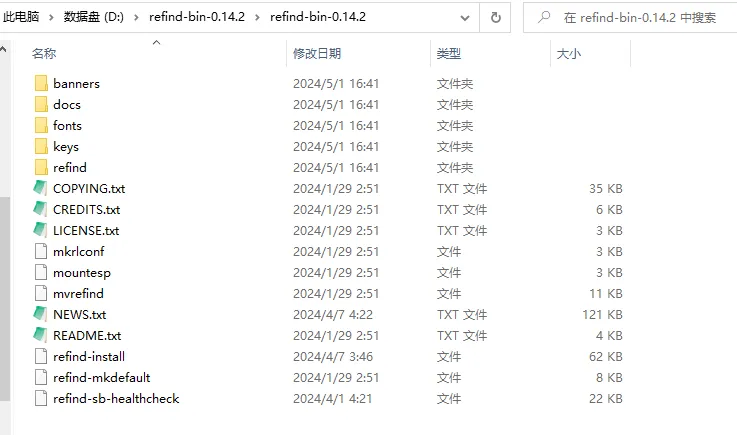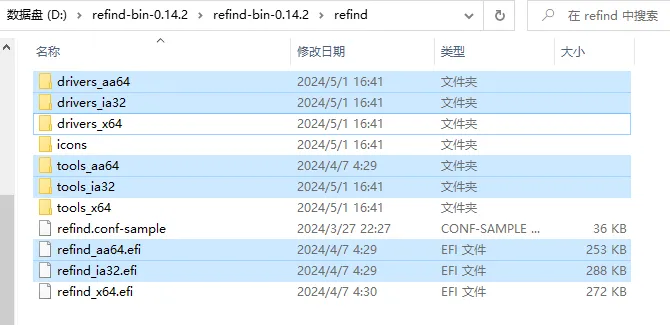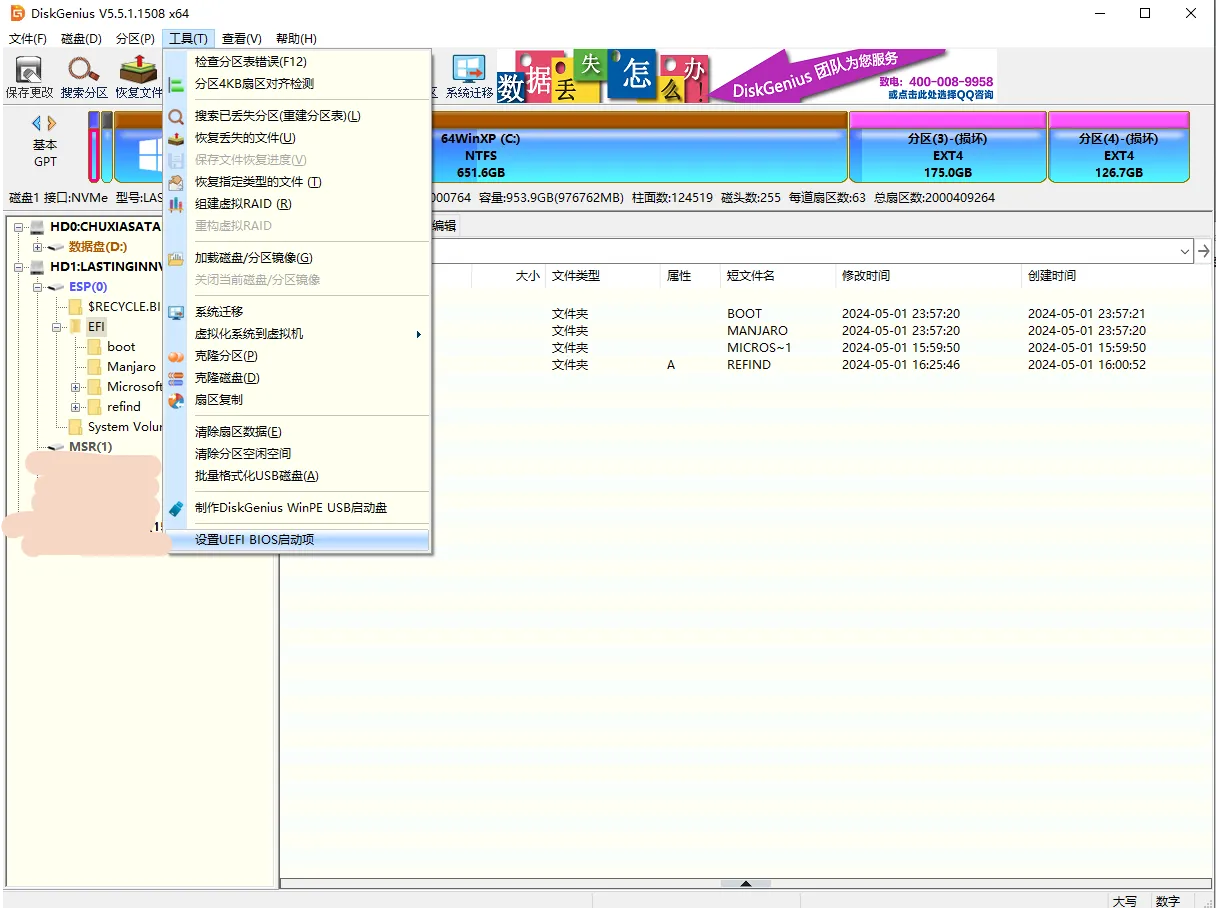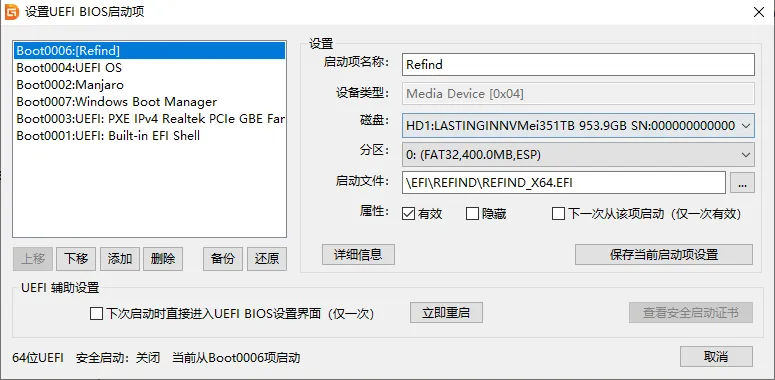
Refind 多系统引导教程

一般情况下,电脑会安装 Windows 和 Linux 双系统,甚至加上 MAC OS 三系统。那么多系统引导一般采用的是 Linux 的引导项作为首选项,因为 Windows 无法引导 Linux。但是这样很不美观而且无法自定义。所以为了方便使用,写了关于多系统引导工具ReFind的使用教程。
1.准备工具
PE盘(自行准备)
Refind(下载地址:https://sourceforge.net/projects/refind/)
2.准备 Refind 工具
下载 refind 压缩包之后,解压会得到下面这些文件

进入refind文件夹,就是我们需要用到的所有文件,其中
aa64和ia32是精简指令集,不需要,将这些文件夹全部删除,加快开机速度。

这样 refind 工具所需要的文件就获取完成。
3. 替换EFI文件
关机重启,进入 PE 系统。(这一步不会的可以自行百度)
打开
DiskGenius文件分区助手。找到 ESP 分区的 EFI 文件夹,将refind文件夹整个复制过来,复制完 EFI 分区将会多出一个 refind 文件夹。

我电脑安装了 Windows 系统和 Manjaro 系统,这两个文件夹里面放的都是各自的引导文件,不要动!!
4. 添加Refind引导
在
DiskGenius的工具栏中,选择设置UEFI BIOS启动项打开。

添加 Refind 引导,启动文件一定要选择 REFIND_X64.EFI,并将该启动项置于第一位。保存。

将refind.conf-sample文件复制一份,改名为refind.conf作为refind的配置文件。

重启电脑,拔出PE盘,让系统加载 Refind 引导,这时候就会看到 refind 自动匹配出很多启动项。到这里关于Refind的引导替换就结束了。
5. Refind的美化和自定义
因为默认的refind很丑,而且启动项很多。需要对refind进行美化和启动项的裁剪。
在Github的 refind-theme Topic中有很多开源的主题,可以选择自己喜欢的主题下载。
refind-theme Topic 地址:https://github.com/topics/refind-theme
以我使用的主题为例,将主题文件下载下来之后会得到如下的多个文件夹:

这里我选择 highres 高分辨率的主题文件。将 highres 文件夹重命名为 refind-dreary。
在refind文件夹里创建一个名为 themes 的文件夹用来存放主题文件。将 refind-dreary 文件夹丢进 themes 文件夹内。
可以看到在该主题文件夹内有一个 theme.conf 配置文件,需要在refind的配置文件中包含该文件。

打开
refind.conf配置文件修改默认启动时间,我这里修改为了6s
timeout 6将默认的系统配置全部删除,这里我习惯手动添加
# A sample entry for a Linux 3.13 kernel with EFI boot stub support # on a partition with a GUID of 904404F8-B481-440C-A1E3-11A5A954E601. # This entry includes Linux-specific boot options and specification # of an initial RAM disk. Note uses of Linux-style forward slashes. # Also note that a leading slash is optional in file specifications. menuentry Linux { icon EFI/refind/icons/os_linux.png volume 904404F8-B481-440C-A1E3-11A5A954E601 loader bzImage-3.3.0-rc7 initrd initrd-3.3.0.img options "ro root=UUID=5f96cafa-e0a7-4057-b18f-fa709db5b837" disabled } # Below is a more complex Linux example, specifically for Arch Linux. # This example MUST be modified for your specific installation; if nothing # else, the PARTUUID code must be changed for your disk. Because Arch Linux # does not include version numbers in its kernel and initrd filenames, you # may need to use manual boot stanzas when using fallback initrds or # multiple kernels with Arch. This example is modified from one in the Arch # wiki page on rEFInd (https://wiki.archlinux.org/index.php/rEFInd). menuentry "Arch Linux" { icon /EFI/refind/icons/os_arch.png volume "Arch Linux" loader /boot/vmlinuz-linux initrd /boot/initramfs-linux.img options "root=PARTUUID=5028fa50-0079-4c40-b240-abfaf28693ea rw add_efi_memmap" submenuentry "Boot using fallback initramfs" { initrd /boot/initramfs-linux-fallback.img } submenuentry "Boot to terminal" { add_options "systemd.unit=multi-user.target" } disabled } # A sample entry for loading Ubuntu using its standard name for # its GRUB 2 boot loader. Note uses of Linux-style forward slashes menuentry Ubuntu { loader /EFI/ubuntu/grubx64.efi icon /EFI/refind/icons/os_linux.png disabled } # A minimal ELILO entry, which probably offers nothing that # auto-detection can't accomplish. menuentry "ELILO" { loader \EFI\elilo\elilo.efi disabled } # Like the ELILO entry, this one offers nothing that auto-detection # can't do; but you might use it if you want to disable auto-detection # but still boot Windows.... menuentry "Windows 7" { loader \EFI\Microsoft\Boot\bootmgfw.efi disabled } # EFI shells are programs just like boot loaders, and can be # launched in the same way. You can pass a shell the name of a # script that it's to run on the "options" line. The script # could initialize hardware and then launch an OS, or it could # do something entirely different. menuentry "Windows via shell script" { icon \EFI\refind\icons\os_win.png loader \EFI\tools\shell.efi options "fs0:\EFI\tools\launch_windows.nsh" disabled } # MacOS is normally detected and run automatically; however, # if you want to do something unusual, a manual boot stanza may # be the way to do it. This one does nothing very unusual, but # it may serve as a starting point. Note that you'll almost # certainly need to change the "volume" line for this example # to work. menuentry "My macOS" { icon \EFI\refind\icons\os_mac.png volume "macOS boot" loader \System\Library\CoreServices\boot.efi disabled } # The firmware_bootnum token takes a HEXADECIMAL value as an option # and sets that value using the EFI's BootNext variable and then # reboots the computer. This then causes a one-time boot of the # computer using this EFI boot option. It can be used for various # purposes, but one that's likely to interest some rEFInd users is # that some Macs with HiDPI displays produce lower-resolution # desktops when booted through rEFInd than when booted via Apple's # own boot manager. Booting using the firmware_bootnum option # produces the better resolution. Note that no loader option is # used in this type of configuration. menuentry "macOS via BootNext" { icon /EFI/refind/icons/os_mac.png firmware_bootnum 80 disabled }在尾部依次填入以下配置:
scanfor manual ## 关闭自动搜索,打开手动配置 scan_all_linux_kernels false ## 关闭对于所有Linux_Kernel的搜索 include themes/refind-dreary/theme.conf ## 使用自定义主题配置 # 手动添加本机系统 #### Windows #### menuentry "Windows" { icon /EFI/refind/themes/refind-dreary/icons/os_win8.png loader /EFI/Microsoft/Boot/bootmgfw.efi } #### Manjaro #### menuentry "Manjaro" { icon /EFI/refind/themes/refind-dreary/icons/os_manjaro.png loader /EFI/Manjaro/grubx64.efi }这里根据自己的系统添加对应的引导,icon表示对应系统所使用的图标,可以去icon文件夹查看。
下面我会给出我的完整的 refind.conf 文件的内容:
# # refind.conf # Configuration file for the rEFInd boot menu # # Timeout in seconds for the main menu screen. Setting the timeout to 0 # disables automatic booting (i.e., no timeout). Setting it to -1 causes # an immediate boot to the default OS *UNLESS* a keypress is in the buffer # when rEFInd launches, in which case that keypress is interpreted as a # shortcut key. If no matching shortcut is found, rEFInd displays its # menu with no timeout. # timeout 8 # Set the logging level. When set to 0, rEFInd does not log its actions. # When set to 1 or above, rEFInd creates a file called refind.log in # its home directory on the ESP and records information about what it's # doing. Higher values record more information, up to a maximum of 4. # This token should be left at the default of 0 except when debugging # problems. # Default value is 0 # #log_level 1 # Normally, when the timeout period has passed, rEFInd boots the # default_selection. If the following option is uncommented, though, # rEFInd will instead attempt to shut down the computer. # CAUTION: MANY COMPUTERS WILL INSTEAD HANG OR REBOOT! Macs and more # recent UEFI-based PCs are most likely to work with this feature. # Default value is true # #shutdown_after_timeout # Whether to store rEFInd's rEFInd-specific variables in NVRAM (1, true, # or on) or in files in the "vars" subdirectory of rEFInd's directory on # disk (0, false, or off). Using NVRAM works well with most computers; # however, it increases wear on the motherboard's NVRAM, and if the EFI # is buggy or the NVRAM is old and worn out, it may not work at all. # Storing variables on disk is a viable alternative in such cases, or # if you want to minimize wear and tear on the NVRAM; however, it won't # work if rEFInd is stored on a filesystem that's read-only to the EFI # (such as an HFS+ volume), and it increases the risk of filesystem # damage. Note that this option affects ONLY rEFInd's own variables, # such as the PreviousBoot, HiddenTags, HiddenTools, and HiddenLegacy # variables. It does NOT affect Secure Boot or other non-rEFInd # variables. # Default is true # use_nvram false # Screen saver timeout; the screen blanks after the specified number of # seconds with no keyboard input. The screen returns after most keypresses # (unfortunately, not including modifier keys such as Shift, Control, Alt, # or Option). Setting a value of "-1" causes rEFInd to start up with its # screen saver active. The default is 0, which disables the screen saver. # #screensaver 300 # Hide user interface elements for personal preference or to increase # security: # banner - the rEFInd title banner (built-in or loaded via "banner") # label - boot option text label in the menu # singleuser - remove the submenu options to boot macOS in single-user # or verbose modes; affects ONLY macOS # safemode - remove the submenu option to boot macOS in "safe mode" # hwtest - the submenu option to run Apple's hardware test # arrows - scroll arrows on the OS selection tag line # hints - brief command summary in the menu # editor - the options editor (+, F2, or Insert on boot options menu) # badges - device-type badges for boot options # all - all of the above # Default is none of these (all elements active) # #hideui singleuser #hideui all # Set the name of a subdirectory in which icons are stored. Icons must # have the same names they have in the standard directory. The directory # name is specified relative to the main rEFInd binary's directory. If # an icon can't be found in the specified directory, an attempt is made # to load it from the default directory; thus, you can replace just some # icons in your own directory and rely on the default for others. # Icon files may be in any supported format -- ICNS (*.icns), BMP (*.bmp), # PNG (*.png), or JPEG (*.jpg or *.jpeg); however, rEFInd's BMP and JPEG # implementations do not support transparency, which is highly desirable # in icons. # Default is "icons". # #icons_dir myicons #icons_dir icons/snowy # Use a custom title banner instead of the rEFInd icon and name. The file # path is relative to the directory where refind.efi is located. The color # in the top left corner of the image is used as the background color # for the menu screens. Currently uncompressed BMP images with color # depths of 24, 8, 4 or 1 bits are supported, as well as PNG and JPEG # images. (ICNS images can also be used, but ICNS has limitations that # make it a poor choice for this purpose.) PNG and JPEG support is # limited by the underlying libraries; some files, like progressive JPEGs, # will not work. # #banner hostname.bmp #banner mybanner.jpg #banner icons/snowy/banner-snowy.png # Specify how to handle banners that aren't exactly the same as the screen # size: # noscale - Crop if too big, show with border if too small # fillscreen - Fill the screen # Default is noscale # #banner_scale fillscreen # Icon sizes. All icons are square, so just one value is specified. The # big icons are used for OS selectors in the first row and the small # icons are used for tools on the second row. Drive-type badges are 1/4 # the size of the big icons. Legal values are 32 and above. If the icon # files do not hold icons of the proper size, the icons are scaled to # the specified size. The default values are 48 and 128 for small and # big icons, respectively. # #small_icon_size 96 #big_icon_size 256 # Custom images for the selection background. There is a big one (144 x 144) # for the OS icons, and a small one (64 x 64) for the function icons in the # second row. If only a small image is given, that one is also used for # the big icons by stretching it in the middle. If only a big one is given, # the built-in default will be used for the small icons. If an image other # than the optimal size is specified, it will be scaled in a way that may # be ugly. # # Like the banner option above, these options take a filename of an # uncompressed BMP, PNG, JPEG, or ICNS image file with a color depth of # 24, 8, 4, or 1 bits. The PNG or ICNS format is required if you need # transparency support (to let you "see through" to a full-screen banner). # #selection_big selection-big.bmp #selection_small selection-small.bmp # Set the font to be used for all textual displays in graphics mode. # For best results, the font must be a PNG file with alpha channel # transparency. It must contain ASCII characters 32-126 (space through # tilde), inclusive, plus a glyph to be displayed in place of characters # outside of this range, for a total of 96 glyphs. Only monospaced fonts # are supported. Fonts may be of any size, although large fonts can # produce display irregularities. # The default is rEFInd's built-in font, Luxi Mono Regular 12 point. # #font myfont.png # Use text mode only. When enabled, this option forces rEFInd into text mode. # Passing this option a "0" value causes graphics mode to be used. Pasing # it no value or any non-0 value causes text mode to be used. # Default is to use graphics mode. # #textonly # Set the EFI text mode to be used for textual displays. This option # takes a single digit that refers to a mode number. Mode 0 is normally # 80x25, 1 is sometimes 80x50, and higher numbers are system-specific # modes. Mode 1024 is a special code that tells rEFInd to not set the # text mode; it uses whatever was in use when the program was launched. # If you specify an invalid mode, rEFInd pauses during boot to inform # you of valid modes. # CAUTION: On VirtualBox, and perhaps on some real computers, specifying # a text mode and uncommenting the "textonly" option while NOT specifying # a resolution can result in an unusable display in the booted OS. # Default is 1024 (no change) # #textmode 2 # Set the screen's video resolution. Pass this option one of the following: # * two integer values, corresponding to the X and Y resolutions # * one integer value, corresponding to a GOP (UEFI) video mode # * the string "max", which sets the maximum available resolution # Note that not all resolutions are supported. On UEFI systems, passing # an incorrect value results in a message being shown on the screen to # that effect, along with a list of supported modes. On EFI 1.x systems # (e.g., Macintoshes), setting an incorrect mode silently fails. On both # types of systems, setting an incorrect resolution results in the default # resolution being used. A resolution of 1024x768 usually works, but higher # values often don't. # Default is "0 0" (use the system default resolution, usually 800x600). # #resolution 1024 768 #resolution 1440 900 #resolution 3 #resolution max # Enable touch screen support. If active, this feature enables use of # touch screen controls (as on tablets). Note, however, that not all # tablets' EFIs provide the necessary underlying support, so this # feature may not work for you. If it does work, you should be able # to launch an OS or tool by touching it. In a submenu, touching # anywhere launches the currently-selection item; there is, at present, # no way to select a specific submenu item. This feature is mutually # exclusive with the enable_mouse feature. If both are uncommented, # the one read most recently takes precedence. # #enable_touch # Enable mouse support. If active, this feature enables use of the # computer's mouse. Note, however, that not all computers' EFIs # provide the necessary underlying support, so this feature may not # work for you. If it does work, you should be able to launch an # OS or tool by clicking it with the mouse pointer. This feature # is mutually exclusive with the enable_touch feature. If both # are uncommented, the one read most recently takes precedence. # #enable_mouse # Size of the mouse pointer, in pixels, per side. # Default is 16 # #mouse_size 16 # Speed of mouse tracking. Higher numbers equate to faster # mouse movement. This option requires that enable_mouse be # uncommented. # Legal values are between 1 and 32. Default is 4. # #mouse_speed 4 # Launch specified OSes in graphics mode. By default, rEFInd switches # to text mode and displays basic pre-launch information when launching # all OSes except macOS. Using graphics mode can produce a more seamless # transition, but displays no information, which can make matters # difficult if you must debug a problem. Also, on at least one known # computer, using graphics mode prevents a crash when using the Linux # kernel's EFI stub loader. You can specify an empty list to boot all # OSes in text mode. # Valid options: # osx - macOS # linux - A Linux kernel with EFI stub loader # elilo - The ELILO boot loader # grub - The GRUB (Legacy or 2) boot loader # windows - Microsoft Windows # Default value: osx # #use_graphics_for osx,linux # Which non-bootloader tools to show on the tools line, and in what # order to display them: # shell - the EFI shell (requires external program; see rEFInd # documentation for details) # memtest - the memtest86 program, in EFI/tools, EFI/memtest86, # EFI/memtest, EFI/tools/memtest86, EFI/tools/memtest, # or a boot loader's directory # gptsync - the (dangerous) gptsync.efi utility (requires external # program; see rEFInd documentation for details) # gdisk - the gdisk partitioning program # apple_recovery - boots the Apple Recovery HD partition, if present # windows_recovery - boots an OEM Windows recovery tool, if present # (see also the windows_recovery_files option) # mok_tool - makes available the Machine Owner Key (MOK) maintenance # tool, MokManager.efi, used on Secure Boot systems # csr_rotate - adjusts Apple System Integrity Protection (SIP) # policy. Requires "csr_values" to be set. # install - an option to install rEFInd from the current location # to another ESP # bootorder - adjust the EFI's (NOT rEFInd's) boot order # about - an "about this program" option # hidden_tags - manage hidden tags # exit - a tag to exit from rEFInd # shutdown - shuts down the computer (a bug causes this to reboot # many UEFI systems) # reboot - a tag to reboot the computer # firmware - a tag to reboot the computer into the firmware's # user interface (ignored on older computers) # fwupdate - a tag to update the firmware; launches the fwupx64.efi # (or similar) program # netboot - launch the ipxe.efi tool for network (PXE) booting # Default is shell,memtest,gdisk,apple_recovery,windows_recovery,mok_tool,about,hidden_tags,shutdown,reboot,firmware,fwupdate # To completely disable scanning for all tools, provide a showtools line # with no options. # #showtools shell, bootorder, gdisk, memtest, mok_tool, apple_recovery, windows_recovery, about, hidden_tags, reboot, exit, firmware, fwupdate # Additional directories to scan for tools. You may specify a directory # alone or a volume identifier plus pathname. The default is to scan no # extra directories, beyond EFI/tools and any directory in which an EFI # loader is found. # #also_scan_tool_dirs EFI/memtest,ESP2:/EFI/tools/memtest86 # Tool binaries to be excluded from the tools line, even if the # general class is specified in showtools. This enables trimming an # overabundance of tools, as when you see multiple mok_tool entries # after installing multiple Linux distributions. # Just as with dont_scan_files, you can specify a filename alone, a # full pathname, or a volume identifier (filesystem label, partition # name, or partition GUID) and a full pathname. # Default is an empty list (nothing is excluded) # #dont_scan_tools ESP2:/EFI/ubuntu/mmx64.efi,gptsync_x64.efi # Boot loaders that can launch a Windows restore or emergency system. # These tend to be OEM-specific. # Default is LRS_ESP:/EFI/Microsoft/Boot/LrsBootmgr.efi # #windows_recovery_files LRS_ESP:/EFI/Microsoft/Boot/LrsBootmgr.efi # Directories in which to search for EFI drivers. These drivers can # provide filesystem support, give access to hard disks on plug-in # controllers, etc. In most cases none are needed, but if you add # EFI drivers and you want rEFInd to automatically load them, you # should specify one or more paths here. rEFInd always scans the # "drivers" and "drivers_{arch}" subdirectories of its own installation # directory (where "{arch}" is your architecture code); this option # specifies ADDITIONAL directories to scan. # Default is to scan no additional directories for EFI drivers # #scan_driver_dirs EFI/tools/drivers,drivers # Which types of boot loaders to search, and in what order to display them: # internal - internal EFI disk-based boot loaders # external - external EFI disk-based boot loaders # optical - EFI optical discs (CD, DVD, etc.) # netboot - EFI network (PXE) boot options # hdbios - BIOS disk-based boot loaders # biosexternal - BIOS external boot loaders (USB, eSATA, etc.) # cd - BIOS optical-disc boot loaders # manual - use stanzas later in this configuration file # firmware - boot EFI programs set in the firmware's NVRAM # Note that the legacy BIOS options require firmware support, which is # not present on all computers. # The netboot option is experimental and relies on the ipxe.efi and # ipxe_discover.efi program files. # On UEFI PCs, default is internal,external,optical,manual # On Macs, default is internal,hdbios,external,biosexternal,optical,cd,manual # #scanfor internal,external,optical,manual,firmware scanfor manual scan_all_linux_kernels false # By default, rEFInd relies on the UEFI firmware to detect BIOS-mode boot # devices. This sometimes doesn't detect all the available devices, though. # For these cases, uefi_deep_legacy_scan results in a forced scan and # modification of NVRAM variables on each boot. Adding "0", "off", or # "false" resets to the default value. This token has no effect on Macs or # when no BIOS-mode options are set via scanfor. # Default is unset (or "uefi_deep_legacy_scan false") # #uefi_deep_legacy_scan # Delay for the specified number of seconds before scanning disks. # This can help some users who find that some of their disks # (usually external or optical discs) aren't detected initially, # but are detected after pressing Esc. # The default is 0. # #scan_delay 5 # When scanning volumes for EFI boot loaders, rEFInd always looks for # macOS's and Microsoft Windows' boot loaders in their normal locations, # and scans the root directory and every subdirectory of the /EFI directory # for additional boot loaders, but it doesn't recurse into these directories. # The also_scan_dirs token adds more directories to the scan list. # Directories are specified relative to the volume's root directory. This # option applies to ALL the volumes that rEFInd scans UNLESS you include # a volume name and colon before the directory name, as in "myvol:/somedir" # to scan the somedir directory only on the filesystem named myvol. If a # specified directory doesn't exist, it's ignored (no error condition # results). The "+" symbol denotes appending to the list of scanned # directories rather than overwriting that list. # The default is to scan the "boot" and "@/boot" directories in addition # to various hard-coded directories. # #also_scan_dirs boot,ESP2:EFI/linux/kernels #also_scan_dirs boot,@/boot #also_scan_dirs +,@/kernels # Partitions (or whole disks, for legacy-mode boots) to omit from scans. # For EFI-mode scans, you normally specify a volume by its label, which you # can obtain in an EFI shell by typing "vol", from Linux by typing # "blkid /dev/{devicename}", or by examining the disk's label in various # OSes' file browsers. It's also possible to identify a partition by its # unique GUID (aka its "PARTUUID" in Linux parlance). (Note that this is # NOT the partition TYPE CODE GUID.) This identifier can be obtained via # "blkid" in Linux or "diskutil info {partition-id}" in macOS. # For legacy-mode scans, you can specify any subset of the boot loader # description shown when you highlight the option in rEFInd. # The default is "LRS_ESP". # #dont_scan_volumes "Recovery HD" # Directories that should NOT be scanned for boot loaders. By default, # rEFInd doesn't scan its own directory, the EFI/tools directory, the # EFI/memtest directory, the EFI/memtest86 directory, or the # com.apple.recovery.boot directory. Using the dont_scan_dirs option # enables you to "blacklist" other directories; but be sure to use "+" # as the first element if you want to continue blacklisting existing # directories. You might use this token to keep EFI/boot/bootx64.efi out # of the menu if that's a duplicate of another boot loader or to exclude # a directory that holds drivers or non-bootloader utilities provided by # a hardware manufacturer. If a directory is listed both here and in # also_scan_dirs, dont_scan_dirs takes precedence. Note that this # blacklist applies to ALL the filesystems that rEFInd scans, not just # the ESP, unless you precede the directory name by a filesystem name or # partition unique GUID, as in "myvol:EFI/somedir" to exclude EFI/somedir # from the scan on the myvol volume but not on other volumes. # #dont_scan_dirs ESP:/EFI/boot,EFI/Dell,EFI/memtest86 # Files that should NOT be included as EFI boot loaders (on the # first line of the display). If you're using a boot loader that # relies on support programs or drivers that are installed alongside # the main binary or if you want to "blacklist" certain loaders by # name rather than location, use this option. Note that this will # NOT prevent certain binaries from showing up in the second-row # set of tools. Most notably, various Secure Boot and recovery # tools are present in this list, but may appear as second-row # items. # The file may be specified as a bare name (e.g., "notme.efi"), as # a complete pathname (e.g., "/EFI/somedir/notme.efi"), or as a # complete pathname with volume (e.g., "SOMEDISK:/EFI/somedir/notme.efi" # or 2C17D5ED-850D-4F76-BA31-47A561740082:/EFI/somedir/notme.efi"). # OS tags hidden via the Delete or '-' key in the rEFInd menu are # added to this list, but stored in NVRAM. # The default is shim.efi,shim-fedora.efi,shimx64.efi,PreLoader.efi, # TextMode.efi,ebounce.efi,GraphicsConsole.efi,MokManager.efi,HashTool.efi, # HashTool-signed.efi,bootmgr.efi,fb{arch}.efi # (where "{arch}" is the architecture code, like "x64"). # If you want to keep these defaults but add to them, be sure to # specify "+" as the first item in the new list; if you don't, then # items from the default list are likely to appear. # #dont_scan_files shim.efi,MokManager.efi # EFI NVRAM Boot#### variables that should NOT be presented as loaders # when "firmware" is an option to "scanfor". The comma-separated list # presented here contains strings that are matched against the # description field -- if a value here is a case-insensitive substring # of the boot option description, then it will be excluded from the # boot list. To specify a string that includes a space, enclose it # in quotes. Specifying "shell" will counteract the automatic # inclusion of built-in EFI shells. # #dont_scan_firmware HARDDISK,shell,"Removable Device" # Scan for Linux kernels that lack a ".efi" filename extension. This is # useful for better integration with Linux distributions that provide # kernels with EFI stub loaders but that don't give those kernels filenames # that end in ".efi", particularly if the kernels are stored on a # filesystem that the EFI can read. When set to "1", "true", or "on", this # option causes all files in scanned directories with names that begin with # "vmlinuz", "bzImage", or "kernel" to be included as loaders, even if they # lack ".efi" extensions. Passing this option a "0", "false", or "off" value # causes kernels without ".efi" extensions to NOT be scanned. # Default is "true" -- to scan for kernels without ".efi" extensions. # #scan_all_linux_kernels false # Support loaders that have been compressed with gzip. # On x86 and x86-64 platforms, Linux kernels are self-decompressing. # On ARM64, Linux kernel files are typically compressed with gzip, # including the EFI stub loader. This makes them unloadable in rEFInd # unless rEFInd itself uncompresses them. This option enables rEFInd # to do this. This feature is unnecessary on x86 and x86-64 systems. # Default is "false" on x86 and x86-64; "true" on ARM64. # #support_gzipped_loaders true # Combine all Linux kernels in a given directory into a single entry. # When so set, the kernel with the most recent time stamp will be launched # by default, and its filename will appear in the entry's description. # To launch other kernels, the user must press F2 or Insert; alternate # kernels then appear as options on the sub-menu. # Default is "true" -- kernels are "folded" into a single menu entry. # #fold_linux_kernels false # Filename prefixes that indicate a file is a Linux kernel. Files that # begin with any of these strings are treated as Linux kernels, if they # are also EFI boot loaders. To include the default string, use "+" # Default is "vmlinuz,bzImage,kernel", except on ARM64, where it is # "vmlinuz,Image,kernel". # #linux_prefixes vmlinuz,bzImage,kernel #linux_prefixes +,zImage # Comma-delimited list of strings to treat as if they were numbers for the # purpose of kernel version number detection. These strings are matched on a # first-found basis; that is, if you want to treat both "linux-lts" and # "linux" as version strings, they MUST be specified as "linux-lts,linux", # since if you specify it the other way, both vmlinuz-linux and # vmlinuz-linux-lts will return with "linux" as the "version string," which # is not what you'd want. Also, if the kernel or initrd file includes both a # specified string and digits, the "version string" includes both. For # instance, "vmlinuz-linux-4.8" would yield a version string of "linux-4.8". # This option is intended for Arch and other distributions that don't include # version numbers in their kernel filenames, but may provide other uniquely # identifying strings for multiple kernels. If this feature causes problems # (say, if your kernel filename includes "linux" but the initrd filename # doesn't), be sure this is set to an empty string # (extra_kernel_version_strings "") or comment out the option to disable it. # Default is no extra version strings # #extra_kernel_version_strings linux-lts,linux # Write to systemd EFI variables (currently only LoaderDevicePartUUID) when # launching Linux via an EFI stub loader, ELILO, or GRUB. This variable, # when present, causes systemd to mount the ESP at /boot or /efi *IF* either # directory is empty and nothing else is mounted there. # Default is "false" # #write_systemd_vars true # Symlinked loaders will be processed when this setting is set to true. # These are ignored by default as they may result in undesirable outcomes. # This token may, however, be useful on Linux setups that provide symbolic # links in scanned locations that point to kernels in unscanned locations, # such as some openSUSE installations. # #follow_symlinks true # Set the maximum number of tags that can be displayed on the screen at # any time. If more loaders are discovered than this value, rEFInd shows # a subset in a scrolling list. If this value is set too high for the # screen to handle, it's reduced to the value that the screen can manage. # If this value is set to 0 (the default), it's adjusted to the number # that the screen can handle. # #max_tags 0 # Set the default menu selection. The available arguments match the # keyboard accelerators available within rEFInd. You may select the # default loader using: # - A digit between 1 and 9, in which case the Nth loader in the menu # will be the default. # - A "+" symbol at the start of the string, which refers to the most # recently booted loader. # - Any substring that corresponds to a portion of the loader's title # (usually the OS's name, boot loader's path, or a volume or # filesystem title). # You may also specify multiple selectors by separating them with commas # and enclosing the list in quotes. (The "+" option is only meaningful in # this context.) # If you follow the selector(s) with two times, in 24-hour format, the # default will apply only between those times. The times are in the # motherboard's time standard, whether that's UTC or local time, so if # you use UTC, you'll need to adjust this from local time manually. # Times may span midnight as in "23:30 00:30", which applies to 11:30 PM # to 12:30 AM. You may specify multiple default_selection lines, in which # case the last one to match takes precedence. Thus, you can set a main # option without a time followed by one or more that include times to # set different defaults for different times of day. # The default behavior is to boot the previously-booted OS. # #default_selection 1 #default_selection Microsoft #default_selection "+,bzImage,vmlinuz" #default_selection Maintenance 23:30 2:00 #default_selection "Maintenance,macOS" 1:00 2:30 # Enable VMX bit and lock the CPU MSR if unlocked. # On some Intel Apple computers, the firmware does not lock the MSR 0x3A. # The symptom on Windows is Hyper-V not working even if the CPU # meets the minimum requirements (HW assisted virtualization and SLAT) # DO NOT SET THIS EXCEPT ON INTEL CPUs THAT SUPPORT VMX! See # http://www.thomas-krenn.com/en/wiki/Activating_the_Intel_VT_Virtualization_Feature # for more on this subject. # The default is false: Don't try to enable and lock the MSR. # #enable_and_lock_vmx false # Tell a Mac's EFI that macOS is about to be launched, even when it's not. # This option causes some Macs to initialize their hardware differently than # when a third-party OS is launched normally. In some cases (particularly on # Macs with multiple video cards), using this option can cause hardware to # work that would not otherwise work. On the other hand, using this option # when it is not necessary can cause hardware (such as keyboards and mice) to # become inaccessible. Therefore, you should not enable this option if your # non-Apple OSes work correctly; enable it only if you have problems with # some hardware devices. When needed, a value of "10.9" usually works, but # you can experiment with other values. This feature has no effect on # non-Apple computers. # The default is inactive (no macOS spoofing is done). # #spoof_osx_version 10.9 # Set the CSR values for Apple's System Integrity Protection (SIP) feature. # Values are two-byte (four-character) hexadecimal numbers. These values # define which specific security features are enabled. Below are the codes # for what the values mean. Add them up (in hexadecimal!) to set new values. # Apple's "csrutil enable" and "csrutil disable" commands set values of 10 # and 877, respectively. (Prior to OS 11, 77 was used rather than 877; 877 # is required for OS 11, and should work for OS X 10.x, too.) # CSR_ALLOW_UNTRUSTED_KEXTS 0x0001 # CSR_ALLOW_UNRESTRICTED_FS 0x0002 # CSR_ALLOW_TASK_FOR_PID 0x0004 # CSR_ALLOW_KERNEL_DEBUGGER 0x0008 # CSR_ALLOW_APPLE_INTERNAL 0x0010 # CSR_ALLOW_UNRESTRICTED_DTRACE 0x0020 # CSR_ALLOW_UNRESTRICTED_NVRAM 0x0040 # CSR_ALLOW_DEVICE_CONFIGURATION 0x0080 # CSR_ALLOW_ANY_RECOVERY_OS 0x0100 # CSR_ALLOW_UNAPPROVED_KEXTS 0x0200 # CSR_ALLOW_EXECUTABLE_POLICY_OVERRIDE 0x0400 # CSR_ALLOW_UNAUTHENTICATED_ROOT 0x0800 #csr_values 10,877 # Include a secondary configuration file within this one. This secondary # file is loaded as if its options appeared at the point of the "include" # token itself, so if you want to override a setting in the main file, # the secondary file must be referenced AFTER the setting you want to # override. Note that the secondary file may NOT load a tertiary file. # #include manual.conf # Sample manual configuration stanzas. Each begins with the "menuentry" # keyword followed by a name that's to appear in the menu (use quotes # if you want the name to contain a space) and an open curly brace # ("{"). Each entry ends with a close curly brace ("}"). Common # keywords within each stanza include: # # volume - identifies the filesystem from which subsequent files # are loaded. You can specify the volume by filesystem # label, by partition label, or by partition GUID number # (but NOT yet by filesystem UUID number). # loader - identifies the boot loader file # initrd - Specifies an initial RAM disk file # icon - specifies a custom boot loader icon # ostype - OS type code to determine boot options available by # pressing Insert. Valid values are "MacOS", "Linux", # "Windows", and "XOM". Case-sensitive. # graphics - set to "on" to enable graphics-mode boot (useful # mainly for MacOS) or "off" for text-mode boot. # Default is auto-detected from loader filename. # options - sets options to be passed to the boot loader; use # quotes if more than one option should be passed or # if any options use characters that might be changed # by rEFInd parsing procedures (=, /, #, or tab). # disabled - use alone or set to "yes" to disable this entry. # # Note that you can use either DOS/Windows/EFI-style backslashes (\) # or Unix-style forward slashes (/) as directory separators. Either # way, all file references are on the ESP from which rEFInd was # launched. # Use of quotes around parameters causes them to be interpreted as # one keyword, and for parsing of special characters (spaces, =, /, # and #) to be disabled. This is useful mainly with the "options" # keyword. Use of quotes around parameters that specify filenames is # permissible, but you must then use backslashes instead of slashes, # except when you must pass a forward slash to the loader, as when # passing a root= option to a Linux kernel. # Below are several sample boot stanzas. All are disabled by default. # Find one similar to what you need, copy it, remove the "disabled" line, # and adjust the entries to suit your needs. #### Windows #### menuentry "Windows" { icon /EFI/refind/themes/refind-dreary/icons/os_win8.png loader /EFI/Microsoft/Boot/bootmgfw.efi } #### Manjaro #### menuentry "Manjaro" { icon /EFI/refind/themes/refind-dreary/icons/os_manjaro.png loader /EFI/Manjaro/grubx64.efi } include themes/refind-dreary/theme.conf 配置文件中的其他配置选项可以根据说明自定义开启或关闭。
6. 结束
到这里,整个Refind的配置就基本结束了,满足了我对简洁和自定义的要求。

我会把说明文档和Refind文件放在https://github.com/666zhaobo666/Refind- 中,欢迎使用!
- 感谢你赐予我前进的力量



